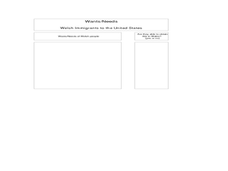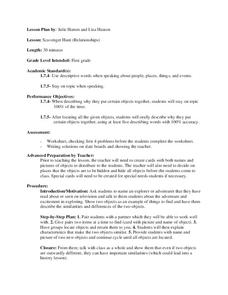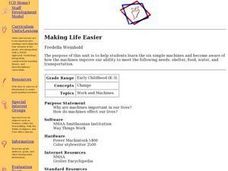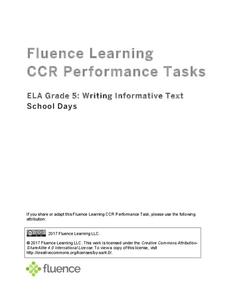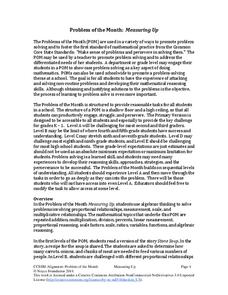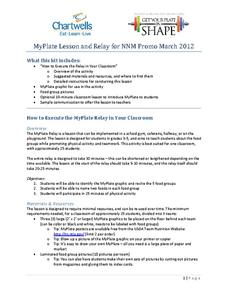Curated OER
Grade Cards
Students examine a school grade card. In this reading lesson, students discuss the school grade card in order to understand how their child is doing in school. Students discuss the symbols and terminology used on the grade cards.
Curated OER
Expansion of Single Brackets
In this expanding brackets worksheet, students read through an explanation of expanding brackets in mathematical equations and then complete 10 practice problems. Students then complete 58 problems in which they need to work through...
Curated OER
Second Grade - Math
In this mixed second grade math review worksheet, 2nd graders answer 25 multiple choice questions. They work with patterns, place value models, fractions, and money in this 8 page worksheet set.
Curated OER
Push/Pull Factors and Welsh Emigration
Students view and discuss short sections of movies that relate to immigration. Working in groups, students create a map that shows directions of internal migration in their assigned geographical area. Students review ads/booklets created...
Curated OER
Contributions - Grade 3
Third graders research and report on the contributions of the First Nations. For this First Nations contribution lesson, 3rd graders read and discuss books about the Metis, Inuit and other First Nations. They compare and contrast the...
Alabama Learning Exchange
Systems Every "Body" Needs to Know
Through an informative WebQuest and group work, learners explore the human body and cell structure. They create a cell diagram, research a disease, write a letter explaining the causes of human disease, and work in small groups to create...
Curated OER
Food Pyramid-Planning a Healthy Meal
Students identify the five basic food groups. They use their knowledge of the food pyramid to plan a full meal that incorporates at least one serving of food from each group. Pupils classify their ingredients according to the food groups.
Curated OER
Disease Prevention and HIV/AIDS Education - Second Grade
Second graders, in groups, rotate to several stations around the room, in which question cards, regarding disease prevention, have be assigned. Groups visit each station, discuss and record their answer to the question and move to the...
Curated OER
Scavenger Hunt
First graders participate in a scavenger hunt. In this grouping instructional activity, 1st graders search for pictures of objects around the room, then find the card with the name of that object written on it. Students also discuss the...
Curated OER
Making Life Easier
Students use a chart of the six simple machines and become aware of how the machines improve our ability to meet the following needs: shelter, food, water, and transportation. Students use model cars to experiment with force. They divide...
Curated OER
Healthy Eaters
Students classify foods as "healthy" or "unhealthy" and sort foods into appropriate food groups. In this nutrition/physical education lesson, students play a game in which throwing skills are practiced. Pictures of food are sorted into...
Curated OER
Complete or Incomplete? That is the Question!
Students work in small groups to determine factors that contribute to a well-done assignment. They report their findings to the rest of the class.
Curated OER
Risk Taking Behaviors
Tenth graders listen to a presenters introduction and write questions they hope to have answered during the presentation. They listen to a presentation and record notes. They participate in small group discussion and complete...
Noyce Foundation
Time to Get Clean
It's assessment time! Determine your young mathematicians' understanding of elapsed time with this brief, five-question quiz.
Fluence Learning
Writing About Literature: Comparing and Contrasting Characters in Heidi
Scholars read excerpts from the story, Heidi, in a three-part assessment that focuses on comparing and contrasting characters. Each part contains three tasks that challenge learners to discuss, answer comprehension questions,...
Fluence Learning
Writing Informative Text: School Days
A three-part writing assessment challenges scholars to think critically about schools of the past and present. Learners read informative texts, answer questions to prepare for a discussion, research in small groups, complete a Venn...
Tech Museum of Innovation
Tree House Escape
Use simple machines to escape from a tree house. Pupils learn about simple machines and how they are useful in everyday life in a STEM lesson. Groups then design a device to rescue a friend stuck in a tree house.
Weebly
Nationalism Project
Don't just ask your class to define nationalism, but invite them to experience it with an engaging project. Learners are divided into groups to design four items—a flag, slogan, national anthem, and historical tale—for a fictional...
Noyce Foundation
Measuring Up
Teach the basics of measurement and conversion with a five-lesson resource that builds an understanding of proportion and measurement conversion from elementary through high school. Initially, young scholars use ratios to determine soup...
EngageNY
Researching Facts
How did the 1906 San Francisco earthquake and fire affect the city's inhabitants? Scholars embark on a quest to discover the answer as they work in small groups to research articles about the event. They finish by completing a jigsaw...
Cartwells
MyPlate Lesson and Relay
Youngsters are up and moving in an exciting relay race designed to help them better understand where common foods fall on the MyPlate nutritional guidelines. Working in teams, they identify images of foods and name what food groups they...
Curated OER
6th Grade Art
Sixth graders create "macquette" sculptures, which would be models for larger playground pieces.
California Department of Education
How to Succeed in Life
Is it possible that six simple traits lead to a happy, successful life? Part four of a six-part series of college and career readiness lessons examines the effects of character in determining success. Working groups discuss...
EngageNY
Discussing and Identifying Themes: What Makes a Good Children’s Book?
Working in small groups, scholars look closely at a children's book to evaluate narrative techniques. Next, they complete a Children's Book Scavenger Hunt worksheet to analyze the literary elements of their selected stories.





